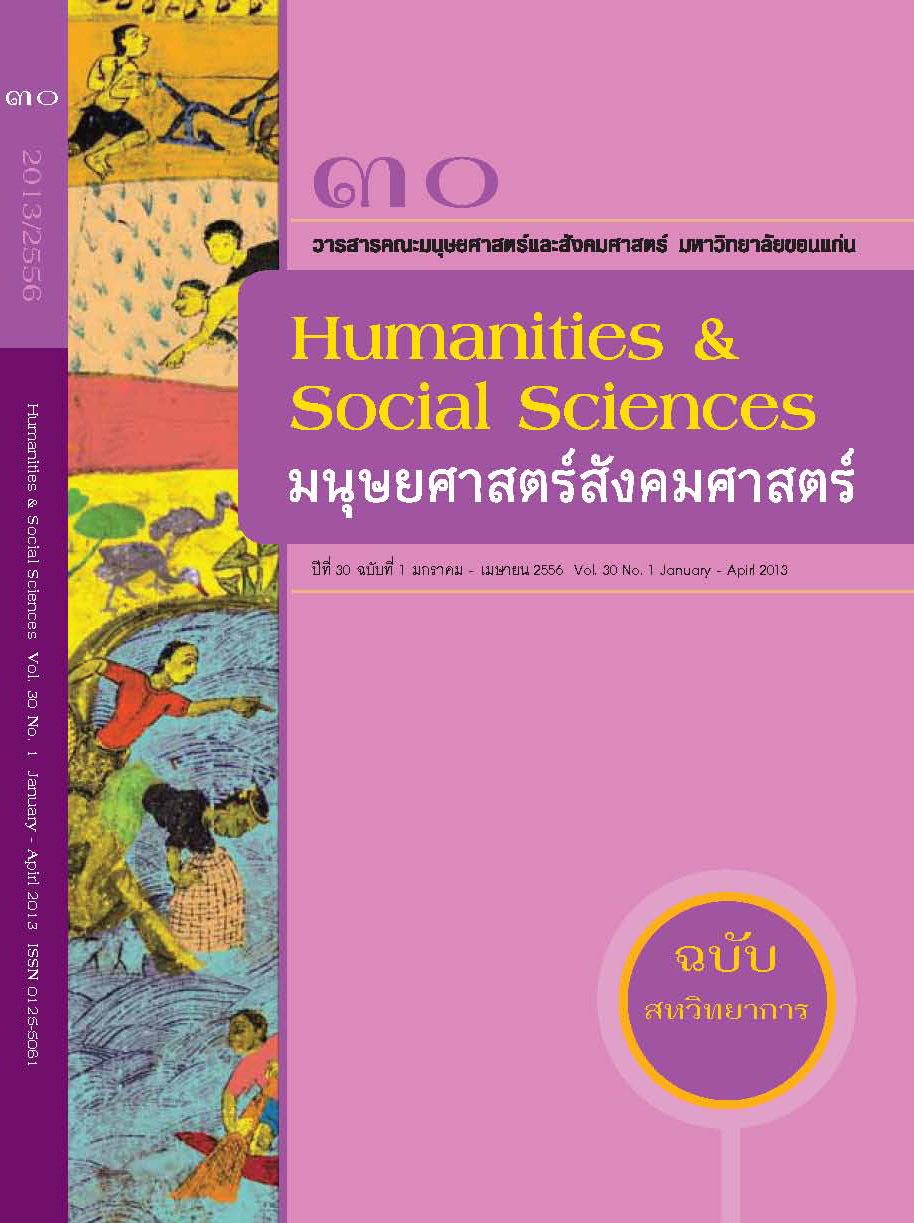The Thai Consonant Adaptation in Teochew Loanwords
Keywords:
ทฤษฏีอุตมผล, การวิเคราะห์แบบการกำหนดข้อบังคับ, แต้จิ๋ว, ไทย, คำยืม, Optimality Theory, constraint-based analysis, Teochew, Thai, loanwordsAbstract
บทคัดย่อแม้ว่าจะมีงานวิจัยมากมายเกี่ยวกับคำยืมภาษาต่าง ประเทศในภาษาไทย แต่มีงานวิจัยที่ศึกษาเกี่ยวกับคำยืมภาษาจีนในภาษาไทยน้อยมาก โดยเฉพาะอย่างยิ่ง ยังไม่มีงานวิจัยใดที่นำเอาทฤษฏีอุตมผล (Optimality Theory) มา ใช้ในการวิเคราะห์คำยืมภาษาจีนในภาษาไทย ดังนั้น วัตถุประสงค์ของงานวิจัยนี้ จึงมีขึ้นเพื่อสำรวจการเปลี่ยนแปลงของพยัญชนะในภาษาแต้จิ๋วในภาษาไทยจากฐาน ข้อมูลออนไลน์ ‘Thai Lexicography Resources’ (Cooper, 2003) โดยใช้ทฤษฎีอุตมผลในการวิเคราะห์ (Prince & Smolensky, 1993) ปรากฏการณ์ที่เกิดขึ้น ผลการศึกษาพบว่า ในตำแหน่งต้นคำ เสียงพยัญชนะส่วนใหญ่ของไทยจะมีการจับคู่แบบตรงกับเสียงพยัญชนะในแต้จิ๋ว ขณะที่เสียงพยัญชนะที่ไม่มีในภาษาไทยของแต้จิ๋วนั้น จะถูกจับคู่กับเสียงพยัญชนะที่มีเสียงใกล้เคียงกันมากที่สุด อนึ่ง ยังพบว่ามีเสียงพยัญชนะในแต้จิ๋วบางตัวที่มีอยู่ในภาษาไทย แต่กลับเปลี่ยนเป็นเสียงพยัญชนะอื่นในภาษาไทย นอกจากนี้ ในตำแหน่งท้ายคำนั้น เสียงพยัญชนะส่วนใหญ่ของแต้จิ๋วมีการจับคู่แบบตรงกับเสียงพยัญชนะของไทย และเสียงพยัญชนะบางตัวในแต้จิ๋วที่มีในไทยกลับไปจับคู่กับเสียงพยัญชนะอื่น ในภาษาไทย ซึ่งปรากฏการณ์ดังกล่าวนี้ สามารถอธิบายได้ด้วยการกำหนดข้อบังคับทั้ง 14 ข้อ เพื่อใช้อธิบายการจับคู่แบบตรง การจับคู่กับหน่วยเสียงที่ไม่มีอยู่ในภาษาผู้รับ และการจับคู่กับหน่วยเสียงอื่นของหน่วยเสียงที่มีอยู่ในภาษาผู้รับ ในคำยืมของแต้จิ๋วในภาษาไทยนี้ มีข้อบังคับความแปลกเด่น (markedness constraint) 4 ข้อได้แก่ *tsh, *ts, *dz, and *g เพราะเสียงดังกล่าว ไม่มีในภาษาไทย ส่วนอีก 10 ข้อนั้น เป็นข้อบังคับแบบซื่อสัตย์ (faithfulness constraint)
คำสำคัญ : ทฤษฏีอุตมผล, การวิเคราะห์แบบการกำหนดข้อบังคับ, แต้จิ๋ว, ไทย, คำยืม
Abstract
Although there are a number of studies on foreign loanwords in Thai; however, very few examine Chinese loanwords in Thai and none of these studies offers a analysis with Optimality Theory. This paper examines the consonant adaptation in Teochew loanwords in Thai from the online database ‘Thai Lexicography Resources’ (Cooper, 2003). This study employs the Optimality Theory (Prince & Smolensky, 1993) to analyse the phenomena. In onset position, most consonants are directly mapped into their counterparts in the recipient language. While some phonemes of Teochew that do not exist in Thai are adjusted to their nearest equivalent segments, there are some which do exist in Thai, but they are paired with other segments. In coda position, the majority of consonants are matched into their counterparts in Thai, some Teochew segments nevertheless are adapted to other phonemes in Thai despite the fact that there are these sounds in Thai phonemic inventory system. The findings show that there are fourteen constraints for describing the situations for direct-mapping, mapping of non-existing consonants, and mapping of existing consonants. There are only four markedness constraints: *tsh, *ts, *dz, and *g; the other ten constraints are faithfulness.
Keywords : Optimality Theory, constraint-based analysis, Teochew, Thai, loanwords



